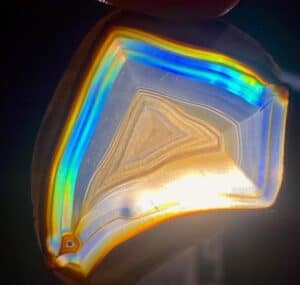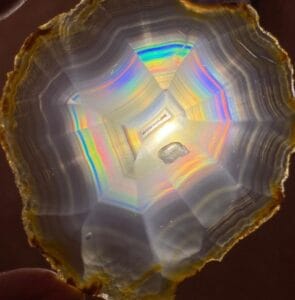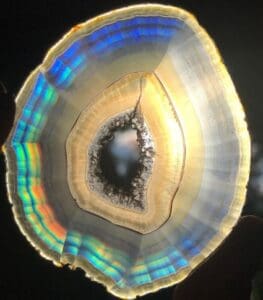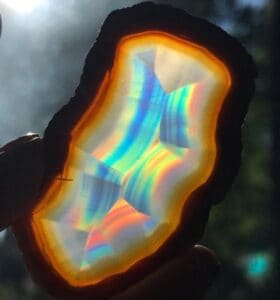Iris Agate is the name used for finely-banded Agates that produce an incredible display of color when it’s cut into a slab with the correct thickness and illuminated from behind. The light travels through the bands of agate and dispersion occurs, aka the rainbow effect.
This material is not very common at rock and mineral shows but you can source it online via Etsy or Instagram. So, you’re probably thinking Iris Agate is some rare variety of Agate but it’s fairly common. Keep reading below and you’ll learn about the different varieties and how to produce your own Iris Agate slabs.
Types of Iris Agates
There are several types of iris Agate, and they’re commonly named after the location in which they’re found. The shapes of the bands will differ between each variety but all of the varieties have the same common traits; thinly sliced slabs, tight bands, and transparent to translucent.
If you have a piece of Agate that is fairly transparent then you can create your own Iris Agate by cutting thin slices.
You’ll need a thin diamond trim saw and the pieces of rough should not be bigger than a baseball. The thinner the slabs are, the stronger the colors will be.

Rainbow Iris Agates
Rainbow Iris Agate is the general trade name given to these thinly sliced Agate slabs. As you can see from the photos, the colors emitted from the light passing through the tight banding is incredible and gives off a rainbow effect.
The colors of the stone when light is transmitted through it are much different from the reflected light. These colors are produced by an optical phenomenon known as diffraction. When light is not passing through the stone the Agate slabs look like normal slabs, slightly milky to off-white in color.

Montana Rainbow Iris Agates
Montana Iris Agates range from nearly clear to a milky gray-blue color but when you send direct light or sunlight through the slab the rainbow phenomenon takes over and produces incredible colors. As the name suggests, these Agates come from Montana and can be found in river beds. Keep in mind the Montana Agate has to have fine layers or tight banding inside of the stone for the phenomenon to occur.

Tennessee Iris Agates
Tennessee is known to produce a few different varieties of Agate. For instance, Greasy Cove is famous for high-quality Paint Rock Agates. Those Agates are commonly found alongside beautiful Iris Agates and a few other varieties. When talking about Iris Agates from Tennessee you can put Greasy Cove down as the first mine to produce Rainbow Agate material
Here’s another explanation of how the diffraction works in Iris Agate. When light hits these Agates, it encounters the edges of the tiny bands. The bands disrupt the flow of light, causing the rays of light to take separate paths throughout the thin bands of the stone. The bands act as a sort of natural diffraction that disperses the light and produces a display of spectral colors.
Unfortunately, these days the Cove is said to be mostly mined out.

Horse Mountain Iris Agate
Horse Mountain is located in Tennessee and has produced some of the finest Iris Agates the rock and mineral industry has ever seen. I’m sure there are rock dealers and rock hounds out there that disagree with this but take a look at the image above. It’s pretty hard to argue against it.
Horse Mountain Iris Agates are from private mines in the middle of Tennessee. There are two basic types of Iris from Horse Mountain, and the first one is the clear to whitish material that is found at all of the private mines. The second is unique, and as far as we know, it contains a brown body color.

Where To Find Iris Agate
Iris Agates can be found in several different locations throughout the United States. Aside from Montana and Tennessee, there are three primary areas in California, one area in Oregon, and a small mine in New Mexico and from time to time Texas will produce some of this material.
- Identify Enstatite - March 12, 2024
- Identify Cerussite - March 3, 2024
- Identify Bytownite - February 18, 2024
